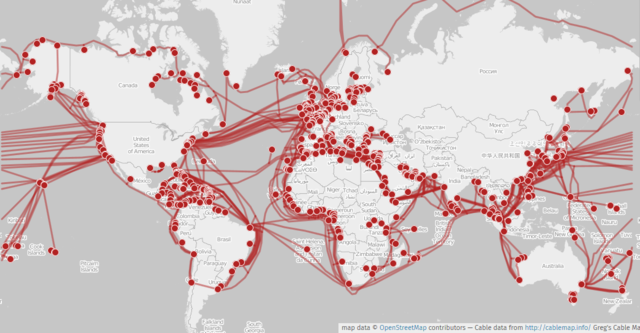
How is the Internet connected between countries? Countries are connected by over 500 underwater communications cables. Many people (myself included), think that international Internet connections are made by satellite, but 95% of them go by undersea cable. Satellites are too expensive and too slow. It takes a long time to transmit a signal to a satellite and back, and you cannot send a lot of data at once. Undersea cables are significantly faster.
The Internet started life in the 1960s. America was trying to ramp up its technology in the face of Russia during the Cold War. Scientists and researchers working on projects would have to travel great distances to access the few computers that had the power to do the calculations they needed. They came up with a way of connecting different terminals to those mainframe computers so they could do the calculations without having to travel. This was the birth of the Internet. The network grew and by 1973, it connected to Hawaii, Norway, and the UK, as well as most of mainland USA. The different types of computers and different programming languages complicated things until transfer Control Protocol / Internetwork Protocol was invented by Bob Kahn and Vint Cerf. This allowed computers to speak the same language and the networks grew. HTML, which is the language Internet browsers use to display the information they download from the Internet was invented in 1993 by Tim Berners Lee and the Internet took off among regular people.
So, how is the Internet connected between countries? All of the countries in the world are connected to each other by relatively thin undersea communications cables. The cables are about the 25 mm to 70 mm. They have a core of fiber optic cables that transmit the data. Then, the rest of the cable is insulation and protection. The outside is a polyethylene sheath, which is the first line of protection for the cable. Under that is a strong plastic known as mylar. Next, we have a layer of steel wires running along the cable. Then there is a layer of aluminium, which keeps the cable waterproof, in case the plastic layers are breached. Then there is another layer of plastic, a copper tube, a layer of petroleum jelly, and finally the fiber optic cables. The cables are thicker in shallow water and thinner in deeper water, because they need more protection where they can be struck by boats.
The data travels down the fiber optic cables at the core of the cable. The speed of the data along the cable varies with its age, but modern cables can send 60 terabytes of data per second. The data travels at about 65% the speed of light. This is an incredibly fast speed, but it is not as fast as people would like. The problem comes because the speed of light is only 100% in a vacuum. The speed of light changes as light passes through any medium, and this is known as the refractive index. The refractive index of light in a vacuum is 1, while it is 1.3 in water. The refractive index for glass, which fiber optic cables are made of, is 1.5, which means that light travels at about 65% its full speed. A second problem is that the cables are not perfectly straight. They have to curve because the Earth isn’t flat. That means the light waves bounce off the sides of the glass cable, reducing their speed even more.
All of the cables are different lengths and go to different places. The longest cable is 45,000 km long, but that doesn’t mean it is entirely under the sea for all of that length. In the early days of cables, they did only go to one place, but today, the cables are connected to many countries that use them and they do this through cable landing points. The cable is split at this point, and a connection is run off to the country that needs it. The landing point connects the undersea cable to that country’s internet connection.
The cables have to be laid by cable laying ships and underwater robots. The majority of the cable will be deep in the sea and there is no way for divers to dive that deep. The first step of laying a cable is to survey the route and make sure there are no cliffs, sunken wreaks or sharp coral reefs. Then the cable layer starts to lower the cable. Because it is hard to bury them, most cables just lie on the sand at the bottom of the sea. However, these days, cable laying companies are trying to work out ways of burying the cables to make them safer. There have been a few cases of cables being cut by ship anchors. Generally, the deeper the sea, the safer it is just to have the cable lying on top of the seabed.
The first undersea cable was a telegraph line between Britain and France in 1850. It was a simple telegraph line. The first cross Atlantic cable was laid in 1858. It took 2 minutes and 5 seconds for a single morse code letter signal to cross the cable. It wasn’t possible to send more than one signal at a time. And this is what I learned today.
Sources
https://www.usg.edu/galileo/skills/unit07/internet07_02.phtml
https://www.scienceandmediamuseum.org.uk/objects-and-stories/short-history-internet
https://www.submarinecablemap.com/
https://www.mentalfloss.com/article/60150/10-facts-about-internets-undersea-cables
https://en.wikipedia.org/wiki/Submarine_communications_cable
https://www.wired.co.uk/article/submarine-internet-cables-egypt
https://edition.cnn.com/2019/07/25/asia/internet-undersea-cables-intl-hnk/index.html
https://en.wikipedia.org/wiki/Refractive_index
